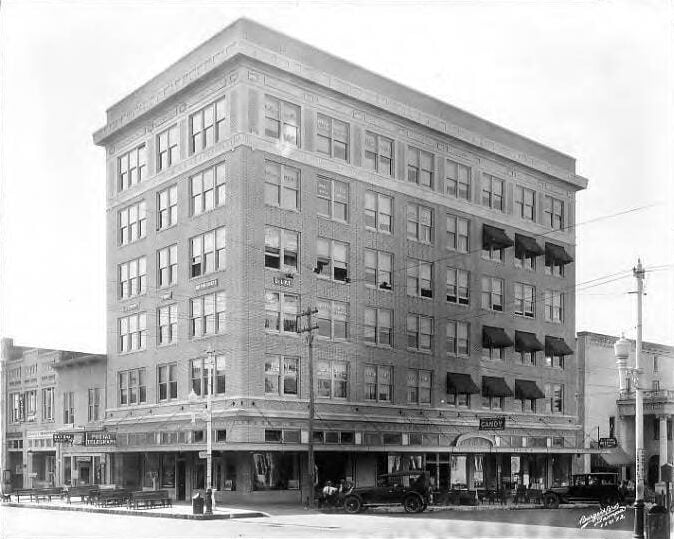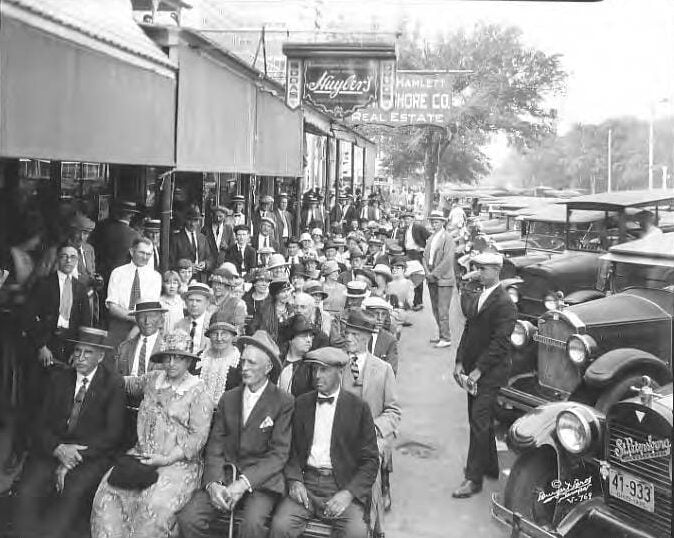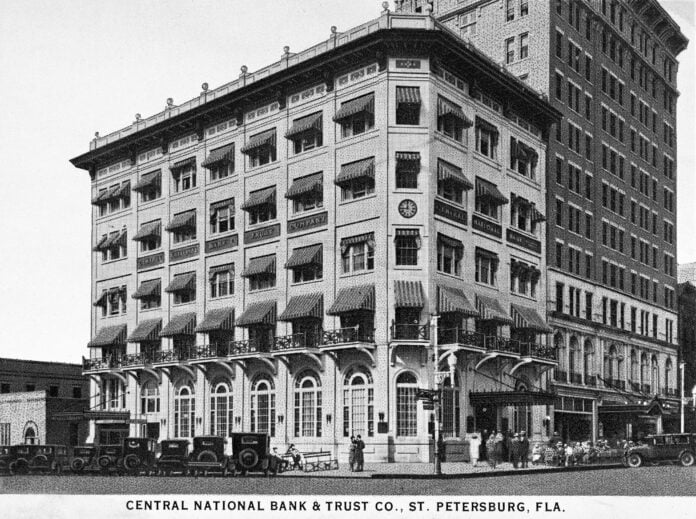The intersection of Fourth Street and Central Avenue has always been the heart of St. Petersburg’s downtown. From the city’s first bank, to the birth of the Green Benches, to a backdrop for Hollywood blockbuster Cocoon, this corner has provided a stage for some of St. Petersburg’s most defining moments. Let’s look at its evolution over the years.
Southwest Corner
The southwest corner, currently a construction site for the 400 Central condominiums, was the center of banking in the city for more than 100 years. The city’s first bank, St. Petersburg State Bank, was founded here in 1893; later, in 1912, the Central National Bank opened a four-story building on the same corner. Next door stood the Pheil Hotel, construction of which began in 1921. In 1959, First National Bank, which had taken over the former Central National Bank building, signed a 99-year lease on the hotel, converting the former first-floor movie theater into the bank’s lobby. In an effort to unify the two distinct buildings, a metal grillwork was wrapped around both structures in 1961, earning the edifice the derisive nickname “the cheese grater.” The hotel, renamed the National Hotel and then the Madison Hotel, closed in 1973. By 2006, the bank had also departed the corner, but the long-term lease, which continued to provide hundreds of thousands of dollars a year to the building’s owners (even though no tenants occupied the space) stymied further activity. The historic buildings were demolished in 2016 after a deal was reached among the Pheil family, First State Bank, and the city. Construction is under way for the 46-story tower, 400 Central, a mix of luxury condominiums, office space, and retail. When completed, it will be the tallest residential tower on the west coast of Florida.

Southeast Corner
Where today’s First Central Tower is located once stood the Hall Building. It opened in 1924 as one of the first office buildings in the city and featured retail on the first floor. Like its neighbors on the southwest and northeast corners, the building was wrapped in faux skin in 1969. Dozens of buildings throughout the city received similar treatment. Typically aluminum, the metal sheaths or grillwork that were wrapped around old buildings were touted for their energy efficiency and privacy, and oddly boasted that they allowed “people inside to see out, without letting people outside see in.” The Hall building was demolished in 1978 for parking for the First Federal Building across the street. By 1984, First Federal built the glass office tower that still stands in that location but had trouble leasing space in an increasingly unpopular downtown. Today, the 17-story building enjoys a 97% occupancy rate, as demand for office space has skyrocketed since its nadir in the 1980s.
Northeast Corner
Today’s Municipal Services Center at 1 Fourth St. N hides a surprise. Underneath exterior panels of a “fractured glass aggregate” lie the remains of the lovely West Coast Title building, opened in 1926. The original Gothic-style structure of limestone, brick, and terra cotta initially occupied only the west end of the northeast corner; a 1958 addition expanded the 10-story building (by then called the First Federal Building) eastward, and covered the older structure and its new addition in a skin of blue enameled tiles. Nicknamed “Big Blue,” the building lost many of its exterior tiles in Hurricane Alma of 1966, and was covered in a new skin in 1967. The city of St. Petersburg bought the building in 1994 and converted it into the Municipal Services Center, bringing city employees who previously were scattered throughout rented buildings downtown under one roof. Proposals were solicited in 2022 for redevelopment of the building. Most proposed demolition. One suggested removing the skin and returning the building to its original glory. The idea for redevelopment of the MSC building was shelved under Mayor Welch’s administration.

Northwest Corner
The northwest corner of Fourth Street and Central has been a popular corner since early pioneer Charles Durant opened a bakery there in the early 1890s. A subsequent store owned by Arthur Norwood featured the city’s first telephone. In 1908, the corner was bought by Noel Mitchell, saltwater-taffy-maker turned real-estate agent, who made it famous as Mitchell’s Corner, declaring it “the heart of the city.” That same year, he placed benches in front of his office to encourage potential patrons to visit. The benches were popular, and neighboring businesses followed suit, until thousands of benches were in place. A 1914 city ordinance mandated that they all be painted green. (They were viewed as a symbol of hospitality by the white community; however, black residents were not permitted to sit on the green benches. They came to symbolize racial division.) In 1917 the corner was sold to prominent real estate developers Perry Snell and J.C. Hamlett. Eleven years later, Snell broke ground on the stunning Snell Arcade. Designed by architects Kiehnel and Elliot, the building is made of glazed terra cotta on the upper floors and Florida keystone and Georgia marble on the ground floor. Original plans called for a second tower, but the Great Depression curtailed the additional construction. The arcade featured 24 stores on the ground floor and offices above. It later became a Walgreens and then part of Rutland’s Department Store. It was renovated in the 1980s and added to both the National Register of Historic Places and the city’s local historic register. Perhaps the renewed attention drew the eye of Hollywood director Ron Howard, who used it as a backdrop for his 1984 movie “Cocoon.” In the early 2000s the upper floors were converted to condominiums, and it remains one of the most striking buildings in the city.





Throughly enjoyed reading. Thank you.